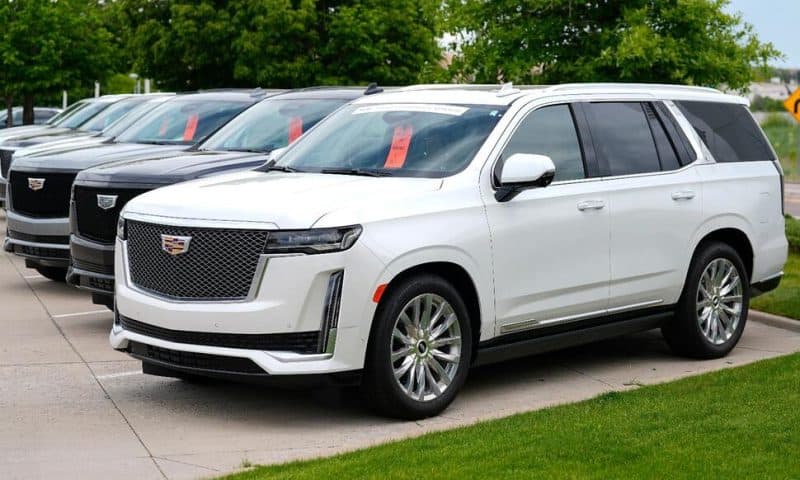U.S. customers who bought a new General Motors vehicle last quarter paid an average of just under $49,900, a price that helped push the company’s net income 15% above a year ago
DETROIT — U.S. customers who bought a new General Motors vehicle last quarter paid an average of just under $49,900, a price that helped push the company’s net income 15% above a year ago.
And GM Chief Financial Officer Paul Jacobson said he doesn’t see his company cutting prices very much, despite industry analysts’ predictions of growing U.S. new-vehicle inventories and bigger discounts.
The Detroit automaker made $2.92 billion from April through June and posted revenue of $47.97 billion. Excluding one-time items, the company made $3.06 per share, 35 cents above Wall Street estimates, according to data provider FactSet, and revenue was better than expected as well.
While the average sales price was down slightly from a year ago, GM sold 903,000 vehicles to dealers in North America during the quarter, 70,000 more than the same period in 2023. Sales in its international unit, however, fell 7,000 to 140,000, the company said.
Still, shares of GM began to fall shortly after the opening bell, as did shares of most other carmakers, due to a number of perceived, potential pitfalls for the industry, including slowing sales in China.
GM is restructuring operations in China which has dragged on its overall performance. Second quarter revenue at GM’s China joint venture reached $4.7 billion, up from $4.1 billion in the first quarter, yet well below the $9.6 billion in sales the unit booked in the final quarter of 2023 and deliveries this year have been declining.
CEO Mary Barra said during a conference call Tuesday that GM is taking steps to reduce inventory in China, as well as looking at how to better align production with demand. She said that the company expects the rest of the year to be difficult and is working aggressively with its joint venture partner to fix it.
“It’s clear the steps we have taken, while significant, have not been enough. We had expected to return to profitability in China in the second quarter. However, we reported a loss, and we expect the rest of the year will remain challenging because the headwinds are not easy,” Barra said. “We are working closely with our JV partner to restructure the business to make it profitable and sustainable.”
Shares of GM, which had risen sharply before the opening bell, slumped almost 7% by midday.
Jeff Windau, an analyst with Edward Jones, said that elements of the company’s recent quarter may have accentuated concerns that already exist about the automobile industry.
“A slowdown in sales in China and rising competition among local competitors could be a headwind to profits,” Windau said in an email. “Also, the development of electric vehicles are believed to help support future growth. So a slowdown in production could push out sales growth targets.”
Early in the year GM predicted that prices would drop 2% to 2.5% this year, but so far that hasn’t materialized, Jacobson, GM’s CFO, said. Instead, the company now expects a 1% to 1.5% decline in the second half.
GM’s prices fell slightly, Jacobson said, because a greater share of its sales have come from lower-priced vehicles such as the Chevrolet Trax small SUV, which starts at $21,495 including shipping. The company, he said, has seen strong sales of higher-priced pickup trucks and larger SUVS.
While other companies have raised discounts, GM has been able to stay relatively consistent while gaining U.S. market share, Jacobson said.
Sales and pricing were among the reasons why GM reduced its net income guidance only slightly for the full year, from a range of $10.1 billion to $11.5 billion, to a new range of $10 billion to $11.4 billion.
GM also said it expects to manufacture and sell 200,000 to 250,000 electric vehicles this year. In the first half, though, it has sold only 22,000 in the U.S., its largest market.
The company, Jacobson said, will add $400 million to its first-half spending on marketing from July through December, in part to raise awareness of its EVs. The annual spending on marketing, though, will still be lower than in 2023, he said.
GM spent $500 million during the second quarter on its troubled Cruise autonomous vehicle unit, $100 million less than a year ago. The company said it would indefinitely postpone building the Origin, a six-passenger robotaxi that was planned for Cruise.
The autonomous vehicle unit will rely on next-generation Chevrolet Bolt electric vehicles when it tries to resume carrying passengers without human safety drivers.
Cruise lost its license to autonomously haul passengers in California last year after one of its robotaxis dragged a jaywalking pedestrian — who had just been struck by a vehicle driven by a human — across a darkened street in San Francisco before coming to a stop.
GM had hoped Cruise would be generating $1 billion in annual revenue by 2025, but has scaled back massive investments in the service.
“GM’s shift to a new platform and mention of regulatory concerns does bring into question the timeline for deployment and the potential consumer interest,” said Windau of Edward Jones. “We do believe that the regulators are an issue for autonomous driving and could cause the launch of these type of vehicle to the market to be longer than expected.”

